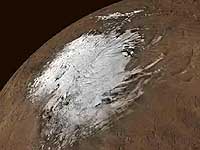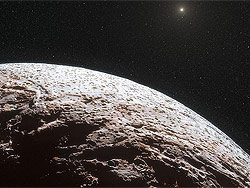    |

 |
|  | |||||||||||||||||||||||||||||||||||||||||||||
Artículos | Espaciales | AstronomíaLa NASA desmentiría a Al Gore: Marte también sufre el cambio climáticoEl calentamiento producido de forma simultánea en la Tierra y en Marte sugiere que los recientes cambios climáticos en nuestro planeta podrían no estar producidos por la acción del hombre, según informa National Geographic. Publicado: Lunes, 5/3/2007 - 12:30 | 4023 visitas.
Esta teoría científica, sin duda controvertida, se basa en datos recogidos por las misiones de la NASA a Marte en el año 2005, en las que se descubrió que el dióxido de carbono en forma de "capas de hielo” cerca del polo sur de Marte se había reducido después de tres veranos consecutivos. Según Habibullo Abdussamatov, responsable del Observatorio Astronómico Pulkovo en San Petesburgo, lo que está sucediendo en Marte evidencia que el actual calentamiento global en la Tierra se debe a cambios en el sol: “El incremento a largo plazo de las radiaciones solares está calentando tanto a la Tierra como a Marte”. A continuación un estracto del artículo (en Inglés) de National Geographic Mars Melt Hints at Solar, Not Human, Cause for Warming, Scientist Says Simultaneous warming on Earth and Mars suggests that our planet"s recent climate changes have a natural—and not a human- induced—cause, according to one scientist"s controversial theory. Earth is currently experiencing rapid warming, which the vast majority of climate scientists says is due to humans pumping huge amounts of greenhouse gases into the atmosphere. Mars, too, appears to be enjoying more mild and balmy temperatures. In 2005 data from NASA"s Mars Global Surveyor and Odyssey missions revealed that the carbon dioxide "ice caps" near Mars"s south pole had been diminishing for three summers in a row. Habibullo Abdussamatov, head of the St. Petersburg"s Pulkovo Astronomical Observatory in Russia, says the Mars data is evidence that the current global warming on Earth is being caused by changes in the sun. "The long-term increase in solar irradiance is heating both Earth and Mars," he said. Solar Cycles Abdussamatov believes that changes in the sun"s heat output can account for almost all the climate changes we see on both planets. Mars and Earth, for instance, have experienced periodic ice ages throughout their histories. "Man-made greenhouse warming has made a small contribution to the warming seen on Earth in recent years, but it cannot compete with the increase in solar irradiance," Abdussamatov said. By studying fluctuations in the warmth of the sun, Abdussamatov believes he can see a pattern that fits with the ups and downs in climate we see on Earth and Mars. Abdussamatov"s work, however, has not been well received by other climate scientists. "His views are completely at odds with the mainstream scientific opinion," said Colin Wilson, a planetary physicist at England"s Oxford University. "And they contradict the extensive evidence presented in the most recent IPCC [Intergovernmental Panel on Climate Change] report." Amato Evan, a climate scientist at the University of Wisconsin, Madison, added that "the idea just isn"t supported by the theory or by the observations." Planets" Wobbles The conventional theory is that climate changes on Mars can be explained primarily by small alterations in the planet"s orbit and tilt, not by changes in the sun. "Wobbles in the orbit of Mars are the main cause of its climate change in the current era," Oxford"s Wilson explained. (Related: "Don"t Blame Sun for Global Warming, Study Says" [September 13, 2006].) All planets experience a few wobbles as they make their journey around the sun. Earth"s wobbles are known as Milankovitch cycles and occur on time scales of between 20,000 and 100,000 years. These fluctuations change the tilt of Earth"s axis and its distance from the sun and are thought to be responsible for the waxing and waning of ice ages on Earth. Mars and Earth wobble in different ways, and most scientists think it is pure coincidence that both planets are between ice ages right now. "Mars has no [large] moon, which makes its wobbles much larger, and hence the swings in climate are greater too," Wilson said. No Greenhouse Perhaps the biggest stumbling block in Abdussamatov"s theory is his dismissal of the greenhouse effect, in which atmospheric gases such as carbon dioxide help keep heat trapped near the planet"s surface. He claims that carbon dioxide has only a small influence on Earth"s climate and virtually no influence on Mars. But "without the greenhouse effect there would be very little, if any, life on Earth, since our planet would pretty much be a big ball of ice," said Evan, of the University of Wisconsin. Most scientists now fear that the massive amount of carbon dioxide humans are pumping into the air will lead to a catastrophic rise in Earth"s temperatures, dramatically raising sea levels as glaciers melt and leading to extreme weather worldwide. Abdussamatov remains contrarian, however, suggesting that the sun holds something quite different in store. "The solar irradiance began to drop in the 1990s, and a minimum will be reached by approximately 2040," Abdussamatov said. "It will cause a steep cooling of the climate on Earth in 15 to 20 years."
| Artículos
Imágenes
Videos
Noticias
EntradasLibros
| ||||||||||||||||||||||||||||||||||||||||||||||




 Imagen: NASA
Imagen: NASA




